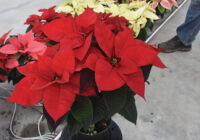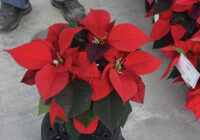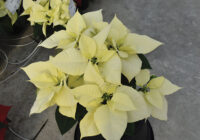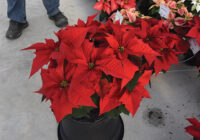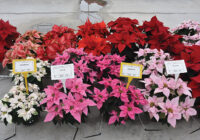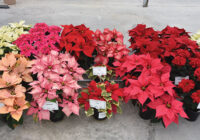
Features
Crops
Flowers
The 2021 Poinsettia Season: Costs, whiteflies and varietal highlights
March 8, 2022 By Melhem Sawaya
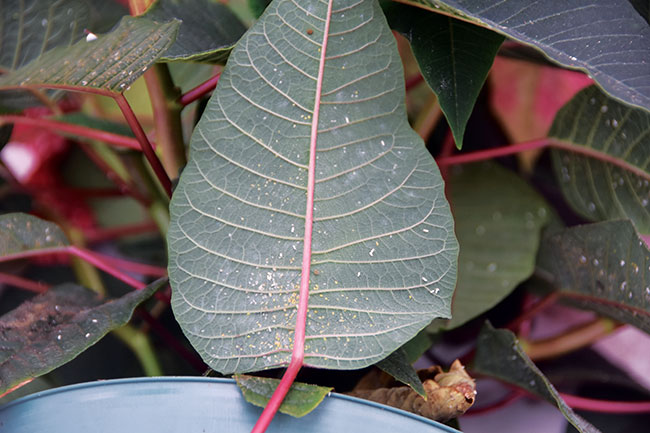 Poinsettias faced high whitefly pressure this past season.
All images by M. Sawaya
Poinsettias faced high whitefly pressure this past season.
All images by M. Sawaya The 2021 poinsettia season in Ontario would have been very successful had it not been for a few key problems:
- A few limited but popular varieties shipped with whiteflies on the cuttings.
- Shipping costs almost doubled due to higher-than-normal demand by other industries.
- Box prices doubled if you had not ordered and received them before the poinsettia shipping season.
- Stores did not want to give enough display area for poinsettias, which led to frequently smaller orders.
Despite these few but costly hiccups, the season wrapped up with strong demand for poinsettia which was helped by mild weather, or at least no snowstorms to stop shipping or shopping in this province. Yes, poinsettia season is as dependent on the weather as the bedding plant season.
Was there any profit in this year’s poinsettia crop?
It would have been a good year except for the cost of production, which kept increasing due to the many factors you would normally have known about early on in the season, such as shipping costs, heat, packaging and imported whiteflies.
With the increased costs of shipping and production, next year’s poinsettia prices should be increased by at least 15 to 20 per cent just to cover it all.
On the positive side, all that was grown was sold along with a two to three per cent shortage, which is where the market should be.
I did not hear of diseases throughout the crop, even without any fungicide applications.
There was no bract edge burn, an issue we haven’t seen in the past 10 years. This coincides with the adoption of biocontrol to manage pests – mainly whitefly. This is a true success story where we solve the problems by eliminating the cause rather than concentrating on the treatment. This is also more economical and greener, avoiding the overuse of chemicals.
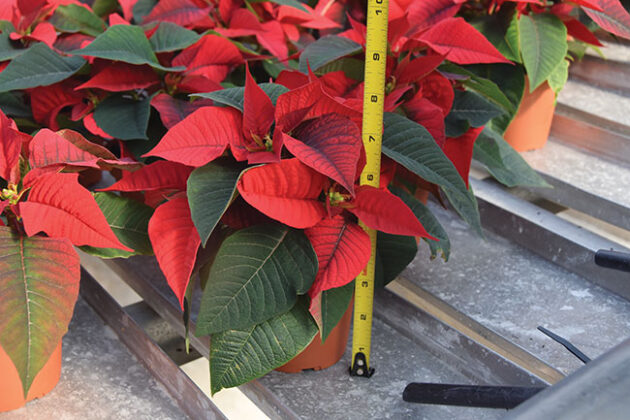
With proper programming and cultural practices, one can produce a multi-bract poinsettia over seven inches tall.
Previously, bract edge burn was mainly due to the use of Thiodan for the control of whiteflies in combination with high humidity in the greenhouse. Most of the time, those from academia or chemical companies would suggest a quick remedy for treating the problem rather than preventing it. The go-to cure was a ton of calcium chloride, but in my opinion, it was only a band-aid and the results were barely satisfactory. This is an example that stresses the need to find the cause of any problem, while looking for ways to remedy it in the meantime.
Production
Weather conditions were optimal for flower initiation – cool nights and higher-than-average light levels. On average, every greenhouse crop was ready a week earlier than other years. In addition to the weather, new varieties have been bred to flower much earlier. In our trials this past year, 96 per cent of the varieties were ready for sale by November 1st.
For those using growth regulators, know that micro drenches of Bonzi can be used at any stage of production and will not reduce the bracts to an unsalable condition. Proper applications of Bonzi can end up producing a much better-quality crop. Like every treatment, if done properly, it can enhance the finished product.
The use of Bonzi micro drenches is a standard procedure, so using it correctly is important. This year, I have seen some plants treated with Bonzi without much of an effect, while in other operations, the effect of Bonzi was too great.
Here are some guidelines to consider when using Bonzi:
- Applications should be uniform, especially if you are using a drip system. Use lower rates with high volumes so the whole root ball is covered. This is also important in non-PGR irrigations with drip systems.
- Treatments are more effective when the plants are in the fast-growing stage. This goes for any growth regulator use.
- Avoid any Bonzi applications overhead, but if that is the only way you can apply it, then rinse with clear water using your sprayer and not watering nozzles.
- Timing is the best growth regulator. Having said that, you cannot delay planting too much in order to get shorter plants because the bracts will not colour properly in low light conditions.
- If a later crop sale date is required, use a later flowering variety in its own section where you can control the temperature without affecting other cultivars. Some crops that were shipped later in the season, but were not programmed for it, showed signs of Botrytis on the bracts, flowers or both.
- If you are spraying Cycocel, be aware of your clear water EC. Because high water ECs adds to that of Cycocel, it could lead to phytotoxicity and leaf damage.
Overall, the best form of Botrytis control is still lower humidity. But to produce the best crops, it’s important to have all aspects of production done on time. Yes, I am saying it again and it will not be the last time: Growing crops is 15 per cent knowledge, 15 per cent knowing how to apply this knowledge, and 70 per cent completing tasks on time. Timing is a major part of growing green because fewer or no chemical treatments will be needed.
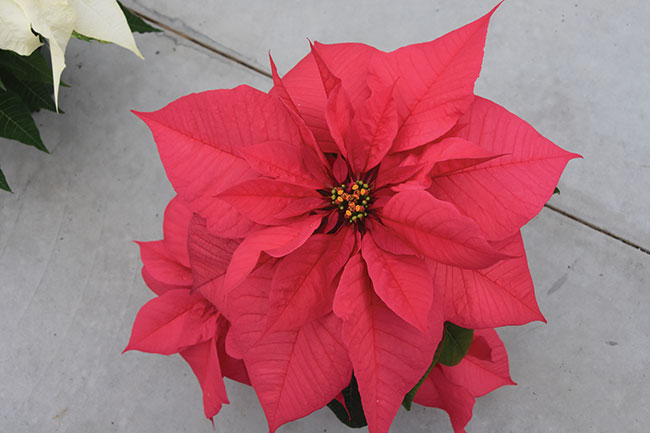
An unpinched Early Polly’s Pink reveals a 13” diameter bract.
Poinsettia Trials
This is the first year where the poinsettia trials took place at our brand-new greenhouse and location at Sawaya Gardens in Waterford, Ont.
Over 150 varieties were propagated by Linwell gardens, then planted in 6” pots at week 31 and pinched during week 34. We had 24 pots of each variety, all watered the same way, with no growth regulators used. This way, the true growth habit of every variety was clearly evident. The following were some of my observations.
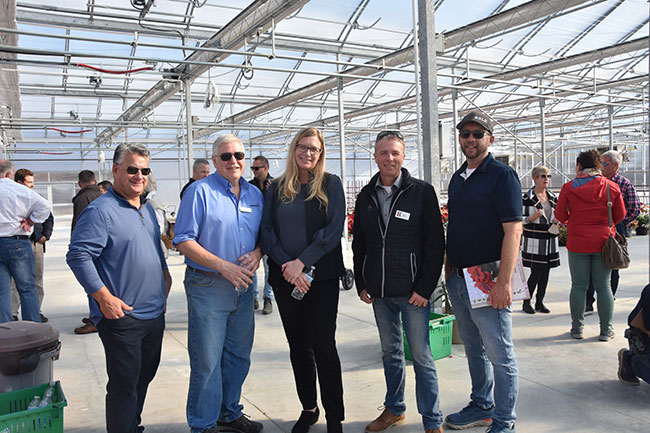
Brokers, breeders, and growers gathered in person.
All trialled varieties could be commercially acceptable for shipping. The first shippable dates recorded varied from Oct. 15 to Nov. 25, but most of them were still shippable past December 15.
Not long ago, we had a maximum of 20 varieties to choose from. In our trials this past year, we had over 150 varieties, and that is not even all of them. The choices are vast, which makes the trials more crucial. This way, we can decide on cultivars that suit our production practices, and more importantly, our customers’ needs.
It’s only when we try some of these varieties in our own production that we can present them to our customers. With unique colours and habits that the breeders come up with, we can capitalize on different packaging options. We can change up the look of poinsettias and go beyond the red, the white and the pink. In bedding plants, mixed containers are so popular that they have almost 50 per cent of the large container market – so why not in poinsettia? In my opinion, the reason why 85 per cent of the poinsettia sold are red is because we are not introducing new cultivars in the same way we do with bedding plants.
After we were done with the trials, we opened the greenhouse to the public for two days. The majority of the consumers came looking for red poinsettia. Instead, many left with four colours and only one that was red. There were so many different options in the trials that they could not leave without selecting two to three of the other colours or shapes. Poinsettia sales could increase by another 10 per cent if we market them like we do bedding plants – well-displayed while taking advantage of all these new varieties.
In our trials, no chemicals were sprayed to control whiteflies, even though some of the varieties had whitefly eggs and larvae on them. The team at BioWorks took charge of whitefly management, and by the time of the open house, I could not see a single whitefly.
The bracts on most of the trialled varieties were larger than normal, most probably because:
- No growth regulators were used.
- The greenhouse was heated to 19 °C and vented at 22 °C.
- They received full sun from sunrise to sunset, independent of temperature.
- There was no delay in bud set. Full sun, which increases the average temperature and maximum light intensity, is a recipe for large bracts.
Production Problems
Diseases: All in all, growers experienced no issues with any kind of diseases except for a few Erwinia incidents that were related to plant stress before sticking.
There were no known issues with rooting problems and no preventative fungicides were applied. Diseases generally do not want anything to do with happy plants, and happy plants do not welcome diseases. Proper watering, checking EC and pH, along with growing in proper environmental conditions all set the stage for healthy plants and lessen the need for fungicides.
Insects: If it had not been for a couple of varieties during certain weeks, then the biocontrol program would have been sufficient to carry the crop all the way to market without any whitefly concerns.
My advice for next year is to check the cuttings thoroughly upon arrival and to discard them if whiteflies are detected. No biocontrol or chemical is going to clean heavily infested cuttings.
Before propagation and planting, the planting areas should be cleaned thoroughly. Ensure that there are no pet plants or other crops around. Here are some general steps to take:
- Open the boxes of cuttings in a cool room and place the cuttings into the BotaniGard solution. Then, put them in a cool room at 10 °C overnight or at least four hours before sticking, making sure the cuttings are never dehydrated.
- Before sticking, dip the cuttings in BotaniGard again.
- Before planting, dip the cuttings in a mixture of horticultural soap
- Start your bio program soon after sticking the cuttings until October around the 10th to the 15th.
- Bios will help keep the crop free of whitefly, or at least leave a negligible amount. This is unless they are overwhelmed by eggs that were heavily loaded on the leaves before the bios had a chance to do their job.
- Scouting and proper management of bios are the main tools to effectively combat whitefly.
Key Takeaways
Here were some key lessons from previous seasons:
- Grow varieties that you are familiar with and try new ones on a small scale.
- Calculate your cost for any required specs and do not forget about packaging and shipping.
- Take an order while there is still some profit margin and not just dollar sales.
- Never grow on pure speculation.
- When you run out of plants at the end of the season and need to buy more, that is when you are starting to make headway profit-wise.
- Do not cheat on what the crop needs to grow properly. It will cost you much more in the end if you do.
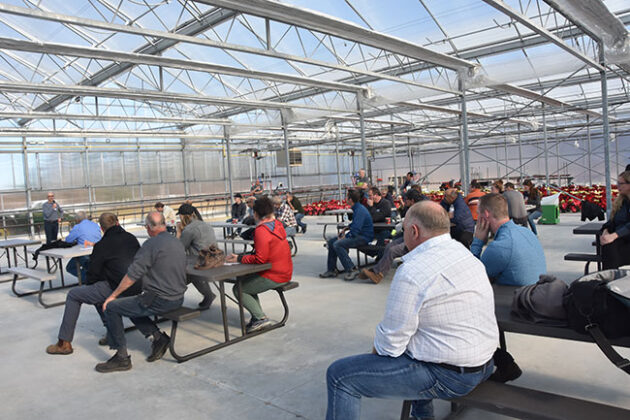
Attendees discussed whitefly issues and management options at the poinsettia trial open house.
Start a study group with the growers in your vicinity. If you are in southwestern Ontario, send me an email and join us. Hopefully, we will be able to make it happen this year.
Any suggestions for the next poinsettia trials are welcome. This year, the open house is scheduled for November 15, 2022.
Varietal highlights
Selecting the highlights among 150 varieties was extremely hard. Suitability ultimately depends on the application. Members of the public who visited the trials chose many varieties that I probably would not have picked.
In selecting these varieties, then, I went with a balance of economics and consumer satisfaction:
[1] Selecta Christmas Bells is a V-shaped variety that does not require a ring and has good lasting quality.
[2] Selecta Alaska White is a very vigorous white variety that needs ringing and if growth is regulated early enough in production, it will become an excellent product at shipping time.
[3] Syngenta Superba New Glitter is a particularly good glitter variety that flowers early with good shelf life.
[4] Syngenta Mirage Red is a great variety that breaks well, is semi-V-shaped and offers long-lasting quality.
[5] Dümmen Orange Imperial Red is a great V-shaped variety that does not need a ring, is easy to sleeve and has great shelf life.
[6] Dümmen Orange Ferrara is another V-shaped variety that is vigorous and ideal for large pots.
[7] Rinehart Pure White is the purest white I’ve seen on the market with a controlled growth habit. It can be grown in any size with proper programming
[8] Dümmen Orange Runway Red is my favourite red poinsettia because of the strong even breaks and layered bracts with the best and largest cyathias I have ever seen. I recommend including a small trial in your production for 2023 as it could become a new favourite.
[9] J’Adore series is a different poinsettia that you can market, not as a variety in a mix, but as a different package altogether to really make a sales impact.
[10] A sample of different poinsettia colours through the years. Red poinsettia accounts for over 90 per cent of production, but with the many colourful varieties now on the market, we can easily increase sales by marketing these colours as we do with bedding plants.
Melhem Sawaya is a greenhouse consultant and owner of Focus Greenhouse Management in Ontario. He can be reached at mel@focusgreenhousemanagement.com
Print this page
